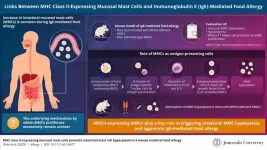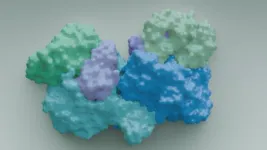Food allergy, or the aggressive immune system reaction following the consumption of a certain food or food ingredient, typically involves immunoglobulin E (IgE) antibodies and can be potentially life-threatening. Often, the immune response to a food protein can be rapid and severe, requiring emergency care. In recent years, scientific studies have revealed that mucosal mast cells (MMCs), which are immune cells that arise from bone marrow, are excessively produced and play a key role in the severity and sudden onset of food allergy symptoms.
However, the precise mechanisms by which MMCs proliferate excessively are yet to be elucidated. To reveal the underlying mechanism behind the overproduction of MMCs during IgE-mediated food allergy, a team of researchers from Juntendo University, Japan, has focused their efforts on studying intestinal mast cell hyperplasia (increased proliferation) in a mouse model of food allergy.
The research team comprised Associate Professor Nobuhiro Nakano and Dr. Jiro Kitaura from Atopy (Allergy) Research Center, Juntendo University Graduate School of Medicine, Japan, along with Dr. Kenji Oishi and Dr. Toshiaki Shimizu from the Department of Pediatrics and Adolescent Medicine, Juntendo University Graduate School of Medicine, Japan. Their research findings were published online in Allergy on January 27, 2025.
“Building on our previous research findings, we developed a method to generate mucosal mast cells from bone marrow cells in an in vitro cell culture system. Remarkably, the mast cells generated using our method expressed major histocompatibility complex class II (MHCII) on their cell surface. Despite MHCII being important for presenting antigens, the role of mast cells as antigen-presenting cells has been unclear. This inspired our research team to investigate the role of mucosal mast cells in the pathogenesis of food allergy,” says Nakano, sharing the motivation behind the present research.
Initially, the researchers generated an IgE-mediated food allergy model using ovalbumin in wild-type BALB/c mice and found that MHCII molecules are expressed on the surface of some MMCs in the intestinal mucosa of the food-allergic mice. Next, they generated mice with MHCII-deficient MMCs and mice with wild-type MMCs and developed an IgE-mediated food allergy model using ovalbumin in these mice. Nakano and co-researchers evaluated the degree of intestinal MMC hyperplasia and the severity of hypothermia in the mice model. Notably, in mice with MHCII-deficient MMCs, the excessive proliferation of intestinal MMCs and hypothermia was suppressed.
Driven by their findings, Nakano and colleagues delved into the finer aspects of the immune response in the IgE-mediated food allergy model. They generated induced MMCs by in vitro differentiation of bone marrow cells derived from mice. In vitro antigen presentation assays revealed that the induced MMCs expressing MHCII molecules were able to ingest the food antigens directly or via antigen-specific IgE and then activate specific T helper cells by antigen presentation.
Further experiments showed that the activated T helper cells were involved in triggering a cascade of molecular interactions by secretion of key interleukins, which are cytokine messenger molecules that stimulate the immune system. Specifically, interleukin-4 (IL-4) and IL-5 were secreted, which significantly enhanced the production of the mast cell growth factor IL-9 by MMCs. Ultimately, excess IL-9 caused the overproduction of MMCs, resulting in exaggerated food allergy symptoms.
“At present, IgE-mediated food allergies are quite prevalent across different regions of the world, but pharmacological agents to manage food allergies are limited,” highlights Nakano. “Our findings can aid the development of medications to alleviate the symptoms of food allergies by inhibiting the excessive proliferation of mucosal mast cells,” concludes Nakano.
In summary, this study unveils the intricate molecular mechanisms involved in immune response during food allergies and sheds light on potential therapeutic strategies to target MHCII-expressing MMCs.
Reference
Authors
Kenji Oishi1, Nobuhiro Nakano2, Masamu Ota2,3, Eisuke Inage1, Kumi Izawa2, Ayako Kaitani2, Tomoaki Ando2, Mutsuko Hara2, Yoshikazu Ohtsuka1, Chiharu Nishiyama3, Hideoki Ogawa2, Jiro Kitaura2, Ko Okumura2, and Toshiaki Shimizu1,2
Title of original paper
MHC class II-expressing mucosal mast cells promote intestinal mast cell hyperplasia in a mouse model of food allergy
Journal
Allergy
DOI
10.1111/all.16477
Affiliations
1Department of Pediatrics and Adolescent Medicine, Juntendo University Graduate School of Medicine, Japan
2Atopy (Allergy) Research Center, Juntendo University Graduate School of Medicine, Japan
3Department of Biological Science and Technology, Faculty of Advanced Engineering, Tokyo University of Science, Japan
About Associate Professor Nobuhiro Nakano
Dr. Nobuhiro Nakano is an Associate Professor at the Atopy (Allergy) Research Center, Juntendo University Graduate School of Medicine, Japan. He has been an active researcher since 2001 and has around 75 research papers to his credit. His research focuses on the areas of food allergy, mast cells, dermatology, and immunology. Besides his teaching experience of more than 20 years, he has been involved in key research projects conducted at Juntendo University, Japan. He has also received numerous awards and honors for his research excellence.
END



